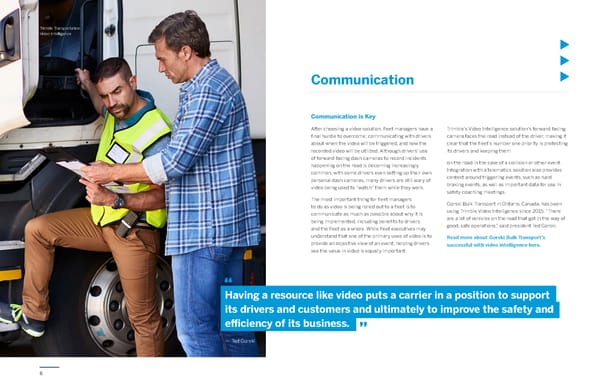6 Trimble Transportation Video Intelligence Having a resource like video puts a carrier in a position to support its drivers and customers and ultimately to improve the safety and efficiency of its business. Communication — Ted Gorski After choosing a video solution, fleet managers have a final hurdle to overcome: communicating with drivers about when the video will be triggered, and how the recorded video will be utilized. Although drivers’ use of forward-facing dash cameras to record incidents happening on the road is becoming increasingly common, with some drivers even setting up their own personal dash cameras, many drivers are still wary of video being used to “watch” them while they work. The most important thing for fleet managers to do as video is being rolled out to a fleet is to communicate as much as possible about why it is being implemented, including benefits to drivers and the fleet as a whole. While fleet executives may understand that one of the primary uses of video is to provide an objective view of an event, helping drivers see the value in video is equally important. Trimble’s Video Intelligence solution’s forward-facing camera faces the road instead of the driver, making it clear that the fleet’s number one priority is protecting its drivers and keeping them on the road in the case of a collision or other event. Integration with a telematics solution also provides context around triggering events, such as hard braking events, as well as important data for use in safety coaching meetings. Gorski Bulk Transport in Ontario, Canada, has been using Trimble Video Intelligence since 2015. “There are a lot of vehicles on the road that get in the way of good, safe operations,” said president Ted Gorski. Read more about Gorski Bulk Transport’s successful with video intelligence here. Communication is Key Trimble Transportation Video Intelligence
 Video Intelligence Protection Prevention Page 5 Page 7
Video Intelligence Protection Prevention Page 5 Page 7